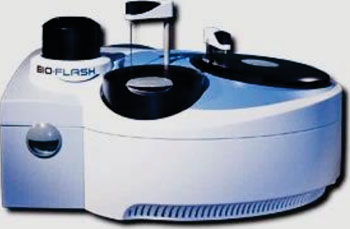Immunoassay Systems Evaluated for Detection of Antiphospholipid Antibodies
By LabMedica International staff writers
Posted on 28 Mar 2016
Antiphospholipid syndrome or antiphospholipid antibody syndrome (APS or APLS), or also Hughes syndrome, is an autoimmune, hypercoagulable state caused by antiphospholipid antibodies. APS provokes blood clots (thrombosis) in arteries and veins as well as pregnancy-related complications such as miscarriage, stillbirth, preterm delivery, and severe preeclampsia.Posted on 28 Mar 2016
The diagnostic criteria require one clinical event, such as thrombosis or pregnancy complication, and two antibody blood tests spaced at least three months apart that confirm the presence of either lupus anticoagulant, or anti-β2-glycoprotein-I (since β2-glycoprotein-I (GpI) antibodies are a subset of anti-cardiolipin antibodies (aCL), an anti-cardiolipin assay can be performed as a less specific proxy.

Image: The Bio-Flash Rapid-Response Chemiluminescent Analyzer (Photo courtesy of Inova Diagnostics).
Scientists at the Hospital Ordine Mauriziano (Torino, Italy) assayed aCL and a-β2GpI in serum samples from 30 healthy individuals, 77 patients with antiphospholipid syndrome (APS) diagnosed according to the Sydney criteria, 51 patients with autoimmune diseases, eight patients with previous thrombotic events, six patients with other diseases, and 18 patients with infectious diseases.
The investigators used the enzyme-linked immunosorbent assay (ELISA, Inova Diagnostics; San Diego, CA, USA); enzyme immunoassays (EliA) (Phadia Laboratory Systems; Freiburg im Breisgau, Germany); chemiluminescence enzyme immunoassay (CliA), (Zenit-RA, A.Menarini Diagnostics; Florence, Italy); and Inova Diagnostics’ CliA Bio-Flash to evaluate analytical and clinical performances of IgG and IgM anticardiolipin (aCL) antibodies and anti-β2-glycoprotein I (a-β2GpI) antibodies and upper limit reference ranges (99th percentiles) in comparison with manufacturer's cutoff values with different commercial methods.
The team found that anticardiolipin and a-β2GpI immunoglobulin G (IgG) and IgM immunoassays showed good analytic performances with both 99th percentile and manufacturer's cutoff reference values. Their results showed fair to moderate agreement among assays. In-house cutoff values gave significantly better performances only for a-β2GpI IgG with all the immunoassays analyzed with the exception of Inova CliA Bio-Flash where they obtained the same performances with in-house and manufacturer's cutoffs.
The authors concluded that by guidelines, all laboratories are strongly advised to validate/verify the manufacturer's cutoff values. They recommended establishing low-positive, medium-/high-positive, and high-positive CliA IgG aCL and a-β2GpI ranges in order to help clinicians in the diagnosis and treatment of APS. The study was published on March 15, 2016, in the International Journal of Laboratory Hematology.
Related Links:
Hospital Ordine Mauriziano
Inova Diagnostics
Phadia Laboratory Systems














